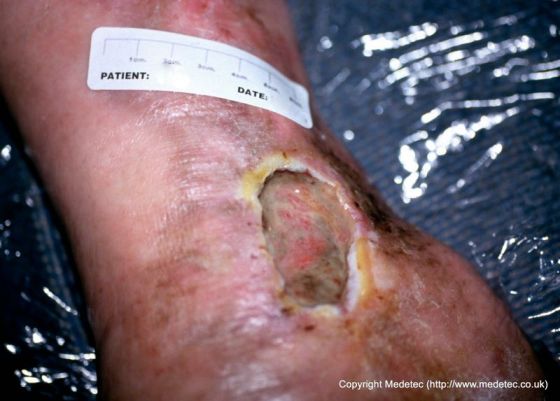Arterial ulcers, also referred to as ischemic ulcers, are caused by poor perfusion (delivery of nutrient-rich blood) to the lower extremities. The overlying skin and tissues are then deprived of oxygen, killing these tissues and causing the area to form an open wound. In addition, the lack of blood supply can result in minor scrapes or cuts failing to heal and eventually developing into ulcers.
The arteries are responsible for carrying nutrient- and oxygen-rich blood to the various tissues in the body. Ischemia, which refers generally to a restriction in the blood supply, can lead to arterial ulcers when it stems from a narrowing of the artery or damage to the small blood vessels in the extremities. The reduced blood flow then in turn leads to tissue necrosis and/or ulceration.
Symptoms of Arterial Ulcers
Arterial ulcers are characterized by a punched-out look, usually round in shape, with well-defined, even wound margins. Arterial ulcers are often found between or on the tips of the toes, on the heels, on the outer ankle, or where there is pressure from walking or footwear. The wounds themselves are characteristically deep, often extending down to the underlying tendons, and will frequently display no signs of new tissue growth. The base of the wound typically does not bleed, and is yellow, brown, grey or black in color.
Often the limb will feel cool or cold to the touch, and the extremity will have little to no distinguishable pulse. The skin and the nails on the extremity will also appear atrophic, with hair loss on the affected extremity, while also taking on a shiny, thin, dry, and taut appearance. In addition, the base color of the extremity may turn red when dangled and pale when elevated. An additional sign of an arterial ulcer is delayed capillary return in the affected extremity.
These ulcers are generally very painful, especially while exercising, at rest, or during the night. A common source of temporary relief from this pain is dangling the affected legs over the edge of bed, allowing gravity to aid blood flow to the ulcerous region.
Arterial ulcers are distinguishable from venous ulcers in that venous ulcers present with redness and edema (swelling) at the site of the ulcer, and may be painless.

Figure 1: An ischemic (arterial) leg ulcer with deep ‘punched out’ appearance
Etiology
The most common causes of arterial ulcers are:
- Restrictions to blood vessels due to peripheral vascular disease
- Chronic vascular insufficiency
- Vasculitis (inflammatory damage of blood vessels)
- Diabetes mellitus
- Renal failure
- High blood pressure
- Arteriosclerosis (hardening of the arteries)
- Atherosclerosis (thickening of the arteries, due to the buildup of fatty materials)
- Trauma
- Limited joint mobility
- Increased age
Risk Factors
A number of risk factors may contribute to the development of an arterial ulcer including the following comorbidities and conditions:
- Diabetes mellitus
- Foot deformity and callus formation resulting in focal areas of high pressure
- Poor footwear that inadequately protects against high pressure and shear
- Obesity
- Absence of protective sensation due to peripheral neuropathy
- Limited joint mobility
Complications
Left untreated, arterial ulcers can lead to serious complications, including infection, tissue necrosis, and in extreme cases amputation of the affected limb.
Diagnostic Studies
- Transcutaneous oxygen measurement
- Toe Brachial Index
- Absolute toe systolic pressure
- Arteriography
- Buerger’s test
- Arterial Doppler studies
Treatment of Arterial Ulcers
The following precautions can help minimize the risk of developing arterial ulcers in at-risk patients and to minimize complications in patients already exhibiting symptoms:
- Examine feet (especially between the toes) and legs daily for any unusual changes in color or the development of sores.
- Quit smoking. Smoking can harden or clog the arteries, leading to improper perfusion to the extremities.
- Manage blood pressure, cholesterol, triglyceride and glucose levels.
- Ensure that footwear is properly fitted to avoid points of rubbing or pressure. Avoid wearing constrictive socks.
- Avoid crossing legs while sitting.
- Avoid sitting or standing for extended periods.
- Avoid cold temperature.
- Protect legs and feet from injury and infection.
- Exercise as frequently as is comfortable.
The primary goal of the treatment of arterial ulcers is to increase circulation to the area, either surgically or medically. Surgical options range from revascularization in order to restore normal blood flow to amputation and rehabilitation in patients who cannot be revascularized. As for non-surgical measures, modifying contributing factors can slow or stop the progression of the local ischemia. Additionally, there are boots and pumps available to augment perfusion to the affected limb.
The ischemic wounds themselves differ from other severe wounds in that the wound environment should be as dry as possible to decrease the risk of infection. The use of cadexomer iodine around the wound margins is an option due to its absorptive properties. This polymer draws exudate and particulate matter from the wound, then when moist releases iodine, serving the dual purpose of cleansing the wound and fighting bacteria at the wound site. Topical antibiotic ointments, such as bacitracin and triple antibiotic, should be used sparingly as they can actually be toxic to cells.
References
Cleveland Clinic. Lower Extremity (Leg and Foot) Ulcers. Cleveland Clinic. http://my.clevelandclinic.org/heart/disorders/vascular/legfootulcer.aspx. Updated November 2010. Accessed August 22, 2019.
Gabriel A. Vascular Ulcers. Medscape Reference. http://emedicine.medscape.com/article/1298345-overview. Updated July 11, 2012. Accessed August 22, 2019.
London Health Sciences Centre. Venous Stasis & Arterial Ulcer Comparison. London Health Sciences Centre. http://www.lhsc.on.ca/Health_Professionals/Wound_Care/venous.htm. Accessed August 22, 2019.
Takahashi P. Chronic Ischemic, Venous, and Neuropathic Ulcers in Long-Term Care. Annals of Long-Term Care. http://www.annalsoflongtermcare.com/article/5980. Published September 5, 2008. Accessed August 22, 2019.

